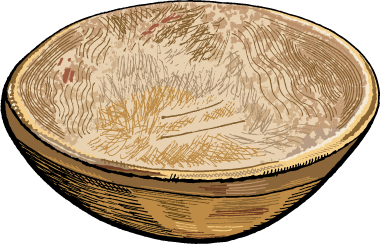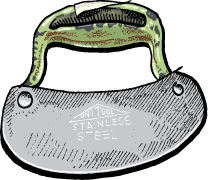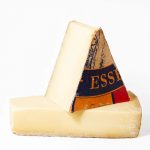Chopped Liver Stories
Part One
It’s nearly twenty years now since I wrote this essay. I think it was a year or so after my grandmother, Belle Perlis, passed away. Writing is one of the best ways I’ve found to get my own feelings out in the open and a way to help me manage grief and pain in difficult situations. The piece was that follows wasn’t particularly planned; I just sat down one day to put some thoughts down after my grandmother had died, and this is what came out. Over the years, many people have encouraged me to reprint it and doing it in this issue of Zingerman’s Newsletter seemed particularly fitting. First because Passover is coming and chopped liver is both the centerpiece of the story and also of my family’s holiday meals. And secondly, since we’re celebrating the 31st anniversary of opening the doors of the Deli, it seems fitting to recognize my grandmother for a couple of her contributions to making Zingerman’s what it is; our chopped liver recipe is still, essentially, what she taught me when we were getting going. She also made a monetary contribution. Along with the $30,000 we borrowed from the bank as a second mortgage on Paul’s house, my grandmother loaded us $2000.
I still have the bowl in the story. I take it out now and again. More than that though, taste our chopped liver with great regularity, in part because it’s delicious, and probably just as much because every time I take a bite it reminds me of some of the more savory, tasty, and terrific culinary memories of my childhood. One bite, I should say, goes a long way and lasts a long time.
![]()
When my grandmother died, I had my first experience with a strange and bittersweet ritual.
It wasn’t what I would have expected my emotions to catch on. The grief, the death, the funeral . . . that’s what I thought would have affected me most. But I’d prepared myself for most of that. The most difficult part of saying good-bye to my grandmother was the seemingly mundane task of dividing up her belongings after the funeral. There was a ghostliness to it, a sense of disenfranchisement. What once was a living and lively home had lost its central focus. And without that focus it became a cross between a folk art museum and an oddly eerie unintentionally created shrine. I felt like I was trespassing in a space I knew, but somehow now barely recognized. I mean, in all my years and years of visiting I’d never really looked at all her things, never violated the privacy of her dresser drawers, her jewelry boxes, her books. Who was I to enter, to alter, to take what was never mine?
So many things, gathered over decades of a life I didn’t live. Gently set into bowls, cached in corners of polished wooden dresser drawers. Saved and scrimped. There were books of S&H green stamps, never to be redeemed (as far as I know, you can’t cash them in heaven), 40-year-old rubber bands, photos of people who were my grandparents yet looked nothing like the people I knew, hated, and loved. All saved and set aside for decades. For what? To be divided up among the people who were still around when they reached their final days. The big things—the stocks, the money, the property, the “economics of death” are made clear in the will. But what do you do with all that “stuff?”
My cousins went for her jewelry; I went for the chopped liver bowl.
It’s a relic, a thing of the past. Today we use food processors and polypropylene cutting boards. Wooden chopping bowls are history. I took my grandmother’s because it’s a relic, as valued as the chips of the jawbone of St. Stephen or St. Francis that I’ve seen cased in glass in the cold and damp stone churches of Europe. A piece of my personal history. When I touch that bowl, I touch Lithuania from whence my grandmother’s parents left for America over a hundred years ago now. I smell it and I smell the south side of Chicago where my grandparents lived when I was growing up. I feel it and I feel the hands of my great-grandfather Beryl Levin, the peddler, who surely ate chopped liver made by his daughter in this same wooden bowl. I look at it and I see my great grandmother, Ida Levin, her hair pulled back from her round face, with lollipop-shaped wire rimmed glasses. She probably had her own chopping bowl, which must have disappeared somewhere into history, probably sold off at somebody’s garage sale for a quarter or two. I never knew Ida Levin. She died before I was born.
But I do know that she brought lunch to her daughter Belle—my grandmother—at school everyday. Did she ever bring chopped liver? My grandmother knew she was a little spoiled—eating the lunch her mother had carried to the schoolyard each day, when all the other kids ate theirs out of brown bags they’d brought from home that morning. I could see it in her 80-year- old eyes when she told me the story. We don’t change much on the inside, only our bodies change around us. Inside my grandmother’s aged, wrinkled, worn face, I could still see the still-a-little-embarrassed eyes of the 12-year-old remembering all those hand-delivered lunches.
My grandmother took more pride in her chopped liver than any other dish she prepared.
You could have monitored my grandmother’s aging in her chopped liver. It was a big concession when she stopped hand- chopping it. Technology won out only because age and weaker hands demanded it. Even though she began using what she called “the processor,” I’m convinced that she always believed in her heart that the hand-chopped liver was better. If nothing else, it proved how much she loved us. Each line, each scar, each scratch in that chopping bowl was put there for love. Maybe I get my stubbornness from my grandmother.
Later, in what must have been her 70s, she let go even more. Reluctantly, she started buying chopped liver at a store—the Romanian Kosher Delicatessen at the corner of Touhy and Clark, a mile or so west of her Lake Shore Drive apartment. I remember that the stuff from Romanian came in plastic containers. It was pastier, smoother, not too bad, but nowhere near as good as my grandmother’s.
In Soviet times, Kremlinologists studied pictures of fat men in overstuffed, medal-adorned wool greatcoats to figure out the inner, unspoken workings of the Kremlin. If they studied my family they’d pore over plates of carefully measured portions of chopped liver to determine who was in and out of favor, who held the highest rank in the family hierarchy. Chopped liver was a tool of administrative architecture, controlled by the power that held sway in the kitchen. The sooner your serving of chopped liver came to the table, the bigger your portion, the higher your family standing.
My sister never liked chopped liver.
How this could have happened is beyond my ability to explain. Supernatural intervention I guess. My sister is the family pleaser, the one who cheated at cards so that I, the oldest, would win. The one who wanted only that everyone else should be happy, and went to great lengths to make that happen. And yet, when the plates of chopped liver came out of the kitchen, my sister’s place setting stayed empty. What could my grandmother have thought about this seeming act of disloyalty? What does it say about our family? How did my sister reconcile her distaste for liver with her love for—and desire to please—our grandmother? She’s always been more traditional than I, my sister. Maybe liver rejection was her rebellion. Like I said, in my family, there was a lot riding on the livers.
My grandmother always served us chopped liver simply, laid out on small plates, pressed down with fork tines to make rows . . . never too neat, but clearly in rows. City boy that I was (and am), I used to daydream the rows into “chopped liver farm fields” at the table while my stepfather monotoned his way through the Kiddush (the blessing on the wine). Platefuls of carefully ploughed chopped liver furrows, ready for the season’s planting.
Today the bowl is scarred. Scraped. Weathered like an old fishing boat, it’s been beaten down by dozens of years and hundreds of pounds of chopped liver. How many times did that metal chopping blade hit the bowl?
I wo nder what happened to that chopper. A crosscut (“waffle cut” I think they call it in catalogues) blade attached to a thin metal handle. Where did it go? I didn’t seeit when we divided up her belongings, but I keep it in my mind, along with memories of my grandmother’s wrinkled fingers, a little wet from washing, grasping the thinhandle, turning the bowl as she chops. Years later it turns up, from whence I know not. Thin, with a well-worn green metal handle. In fact, it turns out there are two—one for meat dishes like liver, the other for dairy. Which tells me there might have been a second wooden bowl for making milk dishes;if there was, it’s long since disappeared.
nder what happened to that chopper. A crosscut (“waffle cut” I think they call it in catalogues) blade attached to a thin metal handle. Where did it go? I didn’t seeit when we divided up her belongings, but I keep it in my mind, along with memories of my grandmother’s wrinkled fingers, a little wet from washing, grasping the thinhandle, turning the bowl as she chops. Years later it turns up, from whence I know not. Thin, with a well-worn green metal handle. In fact, it turns out there are two—one for meat dishes like liver, the other for dairy. Which tells me there might have been a second wooden bowl for making milk dishes;if there was, it’s long since disappeared.
Make of it what you will. I keep that wooden bowl. I treasure it. It’s my past. My pride. My legacy. My cousins can keep the jewelry. The bowl is mine.
Check back tomorrow for the second part of Ari’s essay.




Zingerman’s Art for Sale